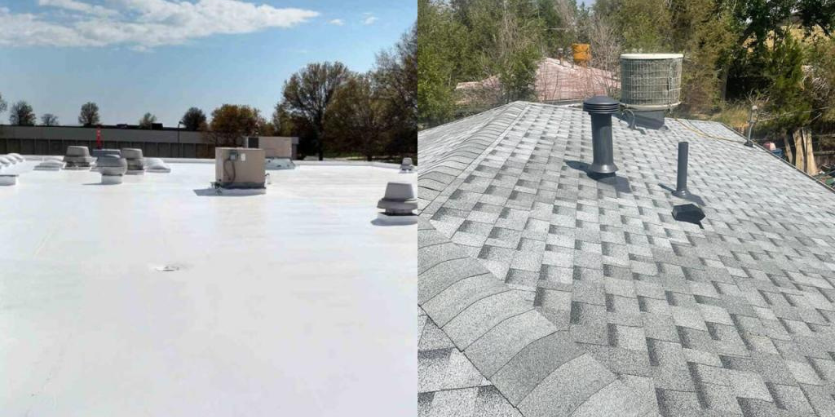One of the most important components of commercial buildings is the roof. You are essentially left with two main options A-flat roofs and Pitched Roofs So which is the best choice for your property? This article will help you understand the differences between a flat roof vs a pitched roof and choose the best option for your property.
What is a Flat Roof?
A flat roof is not completely flat-more of a gentle slope to let water slide off. You can hardly see the slight slope that makes up the inclined roof, which is why it is sometimes referred to as flat. These types of roofs are more likely to be found on commercial buildings, the newest of houses, and also some industrial entities.
Advantages of Flat Roofs
The simple design of flat roofs makes them not too difficult to install. It’s especially convenient for the architectural technician because the staff can do the maintenance work without any problems too.
Cheapness is one of the proudest features of flat roofing. This is because flat roofs use less material and labor to install, which is why they are more affordable first.
However, the flat surface is the best for solar cells. This allows the free electricity that the solar panels generate to be distributed to every circuit of the house, merely using a basic roof outlet to connect the panels.
Moreover, flat roofs don’t complicate the task of installing air conditioning units and other HVAC equipment, as a flat roof is the most convenient place that provides free ground space around the building.
Disadvantages of Flat Roofs
- May have more weaknesses so could be easier to leak
- Life spans are brief
- Regular check-ups and maintenance are required
What is a Pitched Roof?
The term “pitched roof” refers to a roof that is not a flat roof due to its one or multiple slanting surfaces that are typically inclined at an angle of more than 10 degrees each. This roof type is very common in the case of residential buildings roofing where the gable end of houses makes them look like triangles due to their symmetry.
Advantages of Pitched Roof
Out of all the roof types, pitched concrete roofs are known to be durable and have an average lifespan of 20 to 30 years. The fact that the water descends quickly down the inclined roof and does not pool is enough to explain why pitching roofs almost never have water pool issues.
Many people find that the appearance of a roof can have a significant influence on the look of a building. The space can be used as a storage area or even a utility room if the attic under a pitched roof is Full.
However, repair costs may be higher depending on the material of the roof. A properly sloped roof will make the water flow down quickly in stormy surroundings, but one of the negative sides is that the roof is easily damaged under razing gales.
Disadvantages of Pitched Roofs
- It costs more to buy and install a pitched roof
- Occupies more space
- Develops difficulties in the repair process due to high accessibility
Comparing Flat Roof vs Pitched Roof
What if we go through the roofs and see how they compare to each other? Different areas of each type of roof can be compared as shown below:
Justification of the Price
The cost of flat roof vs a pitched roof is a significant aspect to consider. Installation costs of flat roofs and flat roof replacement costs are usually low. However, these might count for more money in the future because of maintenance expenses.
Lifespan
You can look after a flat roof and won’t outlast a pitched roof. Fixing a perfect roof can really last for some 30 years up to even more. Specifications of flat roofs state that they should last from 10 to 20 years on the contrary.
Maintenance
Regular maintenance is more often needed to keep the flat roofs waterproof. Leakage checking is a must and immediate actions should be given for it. On the contrary, the pitched roofs alternate the trend and are for the most part the less heavy-loaded case but access can be more complicated.
Space Usage
The existence of flat roofs leads to the possibility of using them in different ways. For instance, you can have an A/C unit or some plants on the rooftop. The presence of pitched roofs inevitably puts more load on rooftops but can provide some indoor storage for the attic.
Flat Roofing Materials
Flat roofing materials are really diverse so you will mostly be spoilt for choice. Here are some flat roofing materials to choose from:
- EPDM (rubber)
- TPO (thermoplastic)
- Modified Bitumen
- Built-Up Roofing (BUR)
Each type of material has its good and bad sides. The decision of the best one will, of course, depend on the price and the purpose.
Pitched Roofing Materials
Typical of pitched roofs, the materials of them can be the following:
- Asphalt shingles
- Metal roofing
- Slate tiles
- Clay tiles
Then again, it will all depend on what you can afford, where you live, and what kinds of places you are dealing with.
Bottom Line
Selection of the right roof between flat vs pitched roof for your commercial property is a vital, critical decision. Probably both of them look the same but they have their advantages and disadvantages. Moreover, the cost oa f flat roof vs a pitched one plays an important role in the decision-making process. And, it is a good idea to make sure what the local building code is in your area.
Don’t forget to look for a professional who will make a quality installation no matter the type you choose. Maddocks Construction is a renowned company that specializes in the installation of both flat and pitched roofs in commercial properties. We can help you find the best solution for the construction of your building and warrant a high-quality installation.

